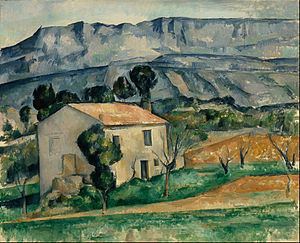Year 1885 (1885) Created 1885 | Type painting on canvas Genre Pastoral Period Post-Impressionism | |
 | ||
Dimensions 65 cm × 81 cm (25.5 in × 32 in) Similar Paul Cézanne artwork, Post-Impressionist artwork, Pastoral artwork | ||
Farmhouse in provence 1888 vincent van gogh
House in Provence is an oil painting by French artist Paul Cézanne. Created in 1885, it is currently part of the permanent collection in the Indianapolis Museum of Art.
Contents
Description
With muted tones and soft colors, Cézanne painted a home, accented by the gray-blue mountains in the background, the soft greens of the rolling hills, and the brown tones of the fields. Cézanne's dynamic style is best observed closely in this painting; the brushstrokes intersect in dynamic way, creating a patchwork. The brushstrokes create lively movement within the hard lines that he creates to border the house and the mountain.
Historical information
House in Provence comes out of Cézanne's 'mature style', where he lived in Provence with his family, where Cézanne lived as a youth. This landscape is set on the South side of Mont Sainte-Victoire, which was a favorite subject of the artist. Cézanne did not share the same interests with the rest of the impressionists, instead focusing his work on the basic structure of his subjects.
Provenance
House in Provence was probably bought by the artist Ambroise Vollard. In 1910, it was sold to Henri Bernstein. It was likely sold to Gottlieb Reber in 1918. It was sold to Marie Harriman by 1936. In 1945, the piece was purchased by Caroloine Marmon Fesler for the John Herron Art Institute, now the Indianapolis Museum of Art, in memory of Daniel W.and Elizabeth C Marmon.
